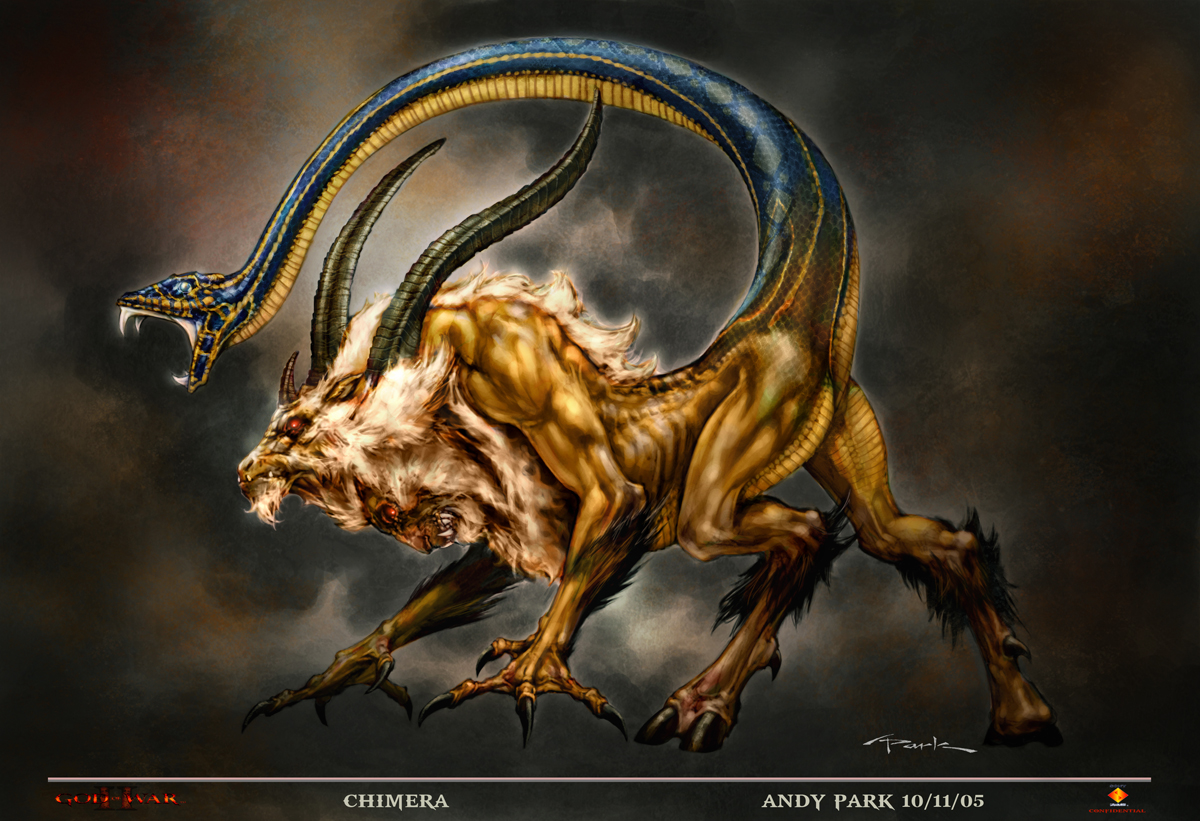|
 ` `
|
In Greek mythology,
the Chimera (Greek Χίμαιρα
(Chímaira); Latin Chimaera) was a
monstrous fire-breathing creature of Lycia
in Asia Minor, composed of the parts
of multiple animals: upon the body of a lioness with a tail that terminated in a snake's head, the head of a goat arose on her back at the center of her spine. The
Chimera was one of the offspring of Typhon and Echidna and a sibling of such monsters as
Cerberus and the Lernaean Hydra. The term
chimera has also come to mean, more generally, an impossible or foolish
fantasy, hard to believe.Homer's brief description in the Iliad
is the earliest surviving literary reference: "a thing of immortal make, not
human, lion-fronted and snake behind, a goat in the middle, and snorting out the breath of the terrible flame of bright fire".
Elsewhere in the
Iliad, Homer attributes the rearing of Chimaera to Amisodorus. Hesiod's Theogony follows the Homeric description: he makes
the Chimera the issue of Echidna: "She was the mother of Chimaera
who breathed raging fire, a creature fearful, great, swift-footed and strong,
who had three heads, one of a grim-eyed lion; in her hinderpart, a dragon; and in her middle, a goat, breathing forth a fearful blast of blazing fire. Her
did Pegasus and noble Bellerophon slay" The author of the
Bibliotheca concurs: descriptions agree
that she breathed fire. The Chimera is
generally considered to have been female (see the quotation from Hesiod above)
despite the mane adorning its lion's head, the inclusion of a close mane
often was depicted on lionesses, but the ears always were visible (that does not
occur with depictions of male lions). Sighting the Chimera was an omen of storms, shipwrecks, and natural disasters (particularly volcanoes).
While there are different genealogies, in one version the Chimera mated with
her brother Orthrus and mothered the
Sphinx and the Nemean lion (others have Orthrus and their mother,
Echidna, mating; most attribute all to Typhon and Echidna).
The Chimera finally was defeated by Bellerophon, with the help of Pegasus, at the command of King Iobates of Lycia. Since Pegasus could fly, Bellerophon shot the
Chimera from the air, safe from her heads and breath. A
scholiast to Homer adds that he
finished her off by equipping his spear with a lump of lead that melted when
exposed to the Chimera's fiery breath and consequently killed her, an image
drawn from metalworking.
The Chimera was situated in foreign Lycia,but her representation in the arts was wholly Greek.An autonomous tradition, one that did not rely on the written word, was
represented in the visual repertory of the Greek vase-painters. The Chimera
first appears at an early stage in the proto-Corinthian
pottery-painters' repertory, providing some of the earliest identifiable
mythological scenes that can be recognized in Greek art. The Corinthian type is fixed,
after some early hesitation, in the 670s BCE; the variations in the pictorial
representations suggest to Marilyn Low Schmitt a multiple origin. The fascination with the monstrous devolved by the end of the
seventh century into a decorative Chimera-motif in Corinth, while the motif of Bellerophon on Pegasus took on a separate existence alone. A
separate Attic tradition, where the goats breathe fire and the animal's rear is
serpent-like, begins with such confidence that Marilyn Low Schmitt is convinced there
must be unrecognized earlier local prototypes. Two vase-painters employed the
motif so consistently they are given the pseudonyms the Bellerophon Painter and
the Chimaera Painter. A fire-breathing lioness was one of the earliest of solar
and war deities in Ancient Egypt (representations from 3000 years prior to the
Greek) and influences are feasible.
In Etruscan civilization, the Chimera
appears in the "Orientalizing" period that precedes Etruscan Archaic art; that
is to say, very early indeed. The Chimera appears in Etruscan wall-paintings of
the fourth century BCE.
Robert Graves
suggests that "the Chimera
was, apparently, a calendar-symbol of the tripartite year, of which the seasonal
emblems were a lion, goat and serpent."
In Medieval art, though
the Chimera of Antiquity was forgotten, chimerical figures appear as embodiments
of the deceptive, even Satanic forces of
raw nature. Provided with a human face and a scaly tail, as in Dante's vision of Geryon in Inferno xvii.7-17, 25-27, hybrid monsters,
more akin to the Manticore of Pliny's
Natural History (viii.90), provided iconic representations of hypocrisy and
fraud well into the seventeenth century, through an emblemmatic representation
in Cesare Ripa's
Iconologia.
In more recent times, the term "chimera" has been used to describe real-life
entities that arise or are created as amalgams of previously separate entities
in fields such as botany, genetics, and molecular biology.
|
 Copyright(c) 2007
- 2020. All rights reserved. Copyright(c) 2007
- 2020. All rights reserved.
|
 `
`![]() Copyright(c) 2007
- 2020. All rights reserved.
Copyright(c) 2007
- 2020. All rights reserved.